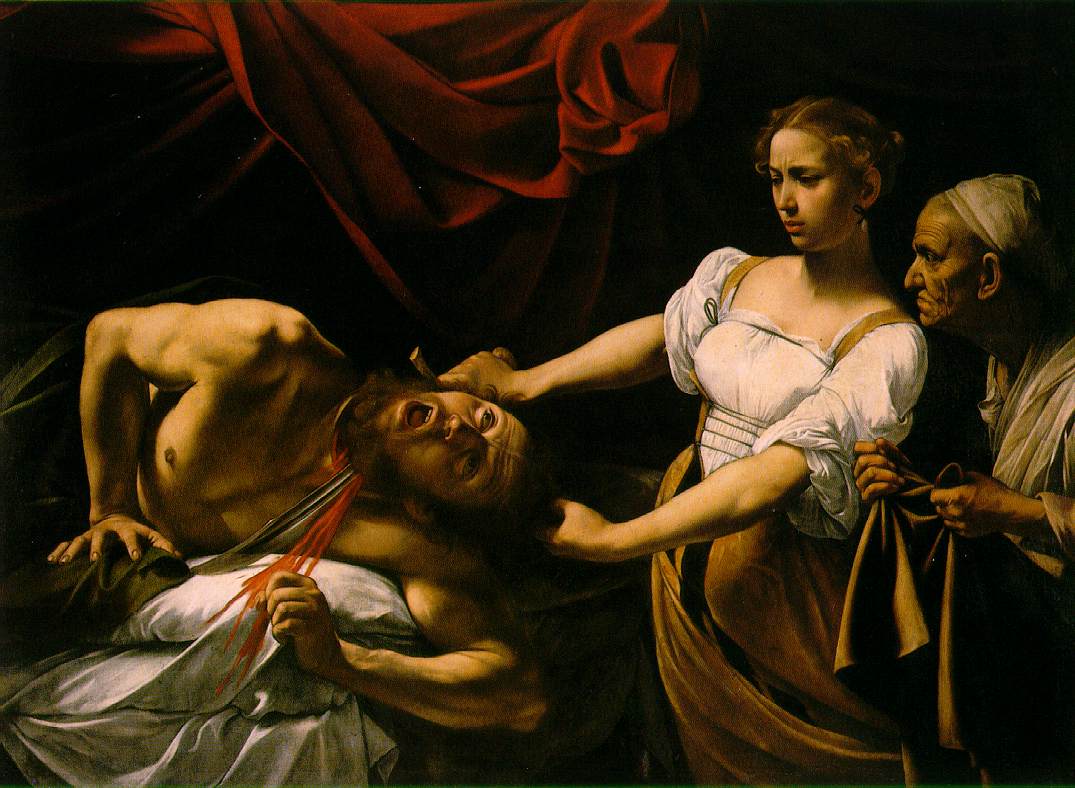An experiment:
When the weekend rolls around, I'll post depictions of the same subject by two different artists and ask for comments or (even better!!) submissions for posts regarding their similarities/differences.
Something provocative, I sense, should kick things off. It's difficult to think of two more provocative works than these. Click on the images to enlarge them: Caravaggio's Judith and Holofernes (ca. 1598)
Caravaggio's Judith and Holofernes (ca. 1598) Artemisia Gentileschi's Judith and Holofernes (1612-21)
Artemisia Gentileschi's Judith and Holofernes (1612-21)
For a quick overview of the relevant events from the book of Judith (which, for my Protestant readers, is in the Apocrypha), here is the Wikipedia entry; and here are the texts of chapters 11, 12, and 13.
Sunday, April 29, 2007
Judith and Holofernes--two paintings
Posted by
John B.
at
3:36 PM
![]()
Labels: Caravaggio, Caravaggio: Judith and Holofernes (painting), Gentileschi, Gentileschi: Judith and Holofernes (painting)
Subscribe to:
Post Comments (Atom)







6 comments:
Admirable gore in both.
Gentileschi's seems more true to the tale in that Judith appears more matronly. Caravaggio portrays her has younger and even highlights that with his choice of maids.
Caravaggios Holofernes shows signs of live and realization in his eyes, whereas Gentileschi's doesn't. With the later, were just waiting for her to finish.
That's all I can come up with in the ten minutes I'm allowing myself for this today.
Cheers.
Thanks for dropping by, Randall.
I suppose the chief difference I note (which is interesting in light of your observations about the respective Holoferneses) is that the Gentileschi has, to my mind, more movement to it--that illuminated pinwheel of limbs is what does it. It's also what a filmmaker would call a tighter shot, which also heightens the intensity of the scene. Caravaggio's Judith seems emotionally detached from what she's doing. Interestingly, though, he had originally had his Judith's breasts exposed (someone came along later and painted the blouse).
I may say more about one or both of these paintings in a future post, but for now I'll conclude by saying that I think Caravaggio is, relatively speaking, more interested in Holofernes than Gentileschi is, and Gentileschi more interested in Judith than Caravaggio is.
Artemesia’s version definitely has a greater sense of violence, of real hands-on butchery. Caravaggio’s version is too stylized: it’s impossible to believe what’s happening – for one thing there’s no way Judith has enough purchase on the sword to actually go about the gruesome business of beheading someone.
Speaking of stylized versions (and taking a step back from the baroque period), I recently saw one of Lucas Cranach’s Judith portraits in Vienna (he painted many different versions): somehow I find it much more disturbing than either of the two more violent depictions.
Grobie,
First of all: Thanks for stopping by and commenting.
Secondly--regarding the Cranch--WOW! You're absolutely right. I think it has something to do with the look on Judith's face: almost smug, her memory filled with the act she's just committed, her red hair standing in for the arterial spurts we see in the Caravaggio and the Gentileschi, her fingers actually still entangled in Holofernes' hair . . . and Holofernes' half-lidded gaze, also regarding the viewer.
So: a double Thank You.
Artemisia is a personal favorite of mine. She represents women in almost considered a radical sort of light in her works, making them strong and independent.
In this particular favorites - My second favorite - She shows a very different attitude in Judith's face, representing a determined and almost feirce expression, whereas Caravaggio represents the Herione as squeamish and uncertain.
They are both very intricate paintings, and I love both of the artists' work, but Artemisia, I would have to say, is the better.
Sorry if my comparisons are juevinille and not backed up; I'm only fifteen, and just an aspiring artist myself.
~
Good dispatch and this fill someone in on helped me alot in my college assignement. Thanks you on your information.
Post a Comment